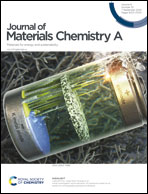A high-output flexible triboelectric nanogenerator based on polydimethylsiloxane/three-dimensional bilayer graphene/carbon cloth composites†
Abstract
Herein, flexible triboelectric nanogenerators (FTENGs) composed of polydimethylsiloxane/3D bilayer graphene/carbon cloth (PDMS/3D BLGr/CC) were prepared via a facile strategy. Gold/polyethylene terephthalate (Au/PET) and the PDMS/3D BLGr/CC composites were employed as the top and bottom electrodes for the FTENGs. Such FTENGs demonstrated maximum values of the peak-to-peak output voltage (70 V), peak-to-peak current density (9.3 μA cm−2), and output power density (0.65 mW cm−2) which are significant when compared to those in the literature. The inherent flexibility was displayed by repeated bending tests at different angles (0–180°) for 1000 cycles, the results of which showed that the FTENG could retain 95.4% of its initial output performance. A working device was fabricated in which FTENGs with areas of 1 cm2 and 9 cm2 could instantaneously light up 28 and 94 green light-emitting diodes. This credibly proves that PDMS/3D BLGr/CC composites can be explored for use in next-generation flexible and wearable energy harvesting systems.



 Please wait while we load your content...
Please wait while we load your content...